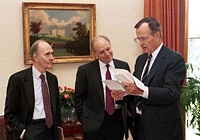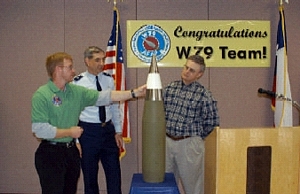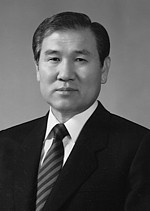Nuclear Brief September 28, 2005
The Withdrawal of U.S. Nuclear Weapons From South Korea
 |
|
The Presidential Nuclear Initiative, announced on
September 27, 1991, led to a withdrawal of all nuclear weapons from South Korea. |
The United States withdrew the last nuclear weapons from South Korea in
December 1991. The initiative was a result of President George H. Bush's
unilateral disarmament initiative in September 1991, which withdrew
tactical nuclear weapons from all overseas locations, except air bombs
from
half a dozen NATO countries in Europe.
Although the South Korean government at the time confirmed the
withdrawal, U.S. affirmations were not as clear. As a result, rumors
persisted for a long time -- particularly in North and South Korea --
that nuclear weapons remained in South Korea. Yet the withdrawal was
confirmed by Pacific Command in 1998 in
a declassified portion of the
CINCPAC Command History for 1991.
In response to President Bush's initiative, CINCPAC
was "specifically tasked to develop a plan for the removal of AFAPs
[Artillery Fired Atomic Projectiles], TOMAHAWK Land Attack Missiles,
Nuclear (TLAM/N), nuclear strike bombs, and nuclear depth bombs (NDBs)
at the earliest opportunity."
President Bush approved the Nuclear Weapons Deployment
Authorization (NWDA) for FY 1991 and FY 1992 on November 5, 1991, as
National Security Directive 64 (NSD-64). According to the CINCPAC
history, "this action cleared the way for the actual return of all
land-based Naval air delivered and sea-based tactical nuclear weapons to
U.S. territory, the withdrawal of all nuclear weapons from Korea, and
other withdrawals in Europe." Moreover, according to
the CINCPAC
history:
"CJCS advised USCINCPAC that the withdrawal of
weapons from Korea had highest priority for transportation assets, with
weapon movements to commence before the next meeting of the ROK-U.S.
Military Committee and Security Committee (MCM/SCM) scheduled for 20-22
November 1991."
 |
|
The last nuclear weapon was withdrawn from South
Korea in December 1991. Nuclear artillery shells, or Artillery
Fired Atomic Projectiles, like this W79, had first priority. The last W79
warhead was dismantled at the Pantex Plan in 2003. |
Of the weapons removed from South Korea, the nuclear
artillery shells had "first priority for transportation,"
according to
CINCPAC. As such, the B61 bombs remained in the country a little longer
until the artillery shells were gone. The withdrawal involved
approximately 60 artillery shells and 40 B61 bombs.
Reactions and Intentions
The
South Korean government Seoul was apparently surprised by President
Bush's initiative, which was primarily a gesture toward the Soviet
Union, and an official reaction was slow in coming. Two weeks after
President Bush's announcement, rumors began circulating in the South
Korean media that Seoul was considering declaring itself nuclear-free
when the U.S. withdrawal had been completed. "It is known that the
government is considering declaring non-existence of nuclear weapons in
South Korea jointly with the U.S. government," the South Korean
newspaper Chosun Ilbo quoted an unidentified government source
saying.
Second-thoughts about the need to withdraw all U.S. nuclear weapons from
Korea also emerged. As the nuclear artillery projectiles began leaving
Kunsan Air Base south of Seoul, the Washington Post reported on
12 October that the U.S. had decided to leave the B61 bombs behind for
the time being. Yet leaving some nuclear weapons in South Korea while at
the same time insisting that North Korea could not develop nuclear
weapons made little sense, and the following week U.S. government
officials told the New York Times that the aircraft bombs would
also be withdrawn. The decision was made, the officials explained, in
part to persuade North Korea to permit international inspection of its
nuclear facilities, and in part because the U.S. military no longer
thought the nuclear bombs were necessary to defend South Korea.
North Korea's first
response to the withdrawal plans was that it would still feel threatened
by U.S. long-range nuclear weapons that could reach North Korea from
elsewhere. On 1 November Reuters reported an article had appeared in
the official North Korean daily Rodong Sinmun ridiculing the U.S.
for talking about removing nuclear weapons from South Korea while
maintaining its nuclear umbrella over the area. "It is only too natural
that we mentioned this U.S. 'nuclear umbrella' for South Korea," the
article said, adding that "they would continue to threaten us with
nuclear weapons in the future. Under such conditions," the paper said,
"the U.S. nuclear threat to us would not be dispelled, even though
nuclear weapons are taken out of South Korea."
While accepting the withdrawal, Seoul insisted that the country remain
under the U.S. nuclear umbrella. So North Korea initially maintained the position that inspections of its nuclear facilities would
not be allowed as long as South Korea remained under the U.S. nuclear
umbrella of sea and air-launched nuclear weapons. But in a major policy
shift on November 26, Pyongyang announced it would allow inspection of
its secret nuclear installations if Washington allowed inspections of
its bases to guarantee that all U.S. nuclear weapons were withdrawn from
South Korea. While officially welcoming President Bush's September
27 initiative, North Korea stated that it would "sign the nuclear
safeguards accord, when the United States begins to withdraw its nuclear
weapons from South Korea."
 |
|
On December 18, 1991, South Korea's President Roh
Tae-Woo declared: "As I speak, there do not exist any nuclear
weapon whatsoever anywhere in the Republic of Korea." |
Two days
later, on November 28, the South Korean Yonhap news agency
reported that South Korea and the U.S. had agreed to complete the
withdrawal by the end of the year and to declare the South free of
nuclear weapons during President Bush's scheduled visit to Seoul in
early January 1992. "North Korea's announcement [to allow inspections if
U.S. nuclear weapons were removed from the South] prompted the two
allies to advance the schedule to removing nuclear arms deployed with
the U.S. forces in Korea," a South Korean government source told the
agency.
Although
one South Korean official told the press that "our government can
confirm the withdrawal," U.S. military officials continued not to
comment on the report, saying: "We neither confirm nor deny the
existence of nuclear weapons here at any time." Yet news about
denuclearizing South Korea were difficult to keep secret, and the New
York Times reported from Seoul on December 11 that it had virtually
been an "open secret that American military forces here have been racing
to dismantle what for three decades constituted the last line of defense
against the North: An arsenal of more than 150 atomic weapons."
By
mid-December, South Korean government officials privately told reporters
that the U.S. had completed its planned withdrawal of nuclear weapons
from South Korea. Finally, on December 18, 1991, South Korean President
Roh Tae-Woo publicly declared that there were no U.S. nuclear weapons in
South Korea: "As I speak, there do not exist any nuclear weapon
whatsoever anywhere in the Republic of Korea," he said. When asked
about Roh's declaration, U.S.
President George H. Bush said that he "heard what Roh said and [I'm] not
about to argue with him."
See
also the other Korea sections:
»
A history of U.S. nuclear weapons in South Korea
»
U.S. nuclear strike planning against North Korea
|

